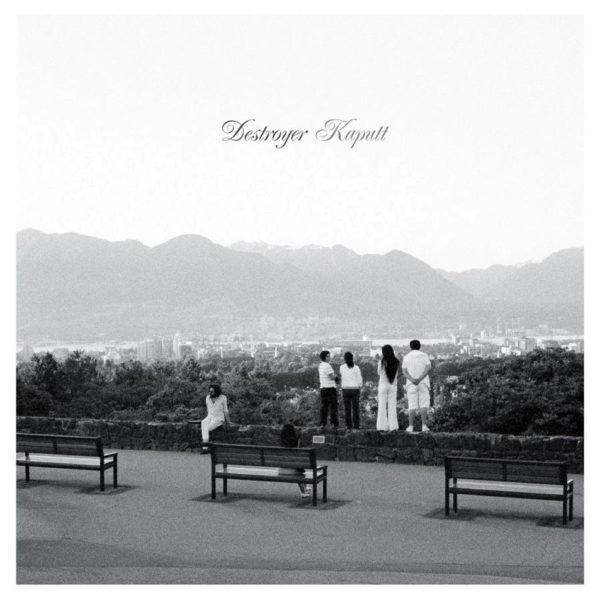Usually music lovers remember the first encounter with their all-time favourite albums, at least in the romanticized analogue High Fidelity-like past. “I found it in an old record store, hidden in the corner”, “My brother gave me the cassette”, “Found it in the shelf of my first girlfriend’s room” etc. … But in the digital age this experience gets as blurry as my memories regarding the album I’m gonna talk about today. I have no vivid memory of when and how Kaputt by Destroyer came into my life. It must have been somewhere in the spring of 2011 while I was struggling with the final examinations of my way too long lasting university career. I think Chinatown was up for a free mp3 download somewhere because that was the time before streaming became a big thing and that was good way of indie labels to get some of the music out. I think I liked it but I have no idea when the full Kaputt record entered my life. The one thing I know is that once it did it became one big musical constant for me over the past decade. It is one of the rare occasions where I not immediately fell in love with the music but my love the album and the project of Dan Bejar continuously grew over the years. To this day I regularly listen to the album, at least every two to three months. I still love every second of it, it never fails to amaze me. I still tend to discover new shades of it every time and I’m not bored of it by now which is quite a thing to manage in this day and age. Unlike other favourite albums which usually arrive to you when you’re in your adolescent period, Kaputt entered my life relatively late, around the time I turned 27. My earliest memories where walks through the summerly city of Jena, shortly before I finished university and moved away from this place. The record arrived at the end of an important phase in my life and at the brink of a new chapter – so that might play a part in this.
When it was released on January 25, 2011 Kaputt was already the ninth studio album by Dan Bejar’s project Destroyer under which he released quite ambitious yet very abstract albums since the mid-90s. Until that time the project was quite a niche topic and Bejar was more known for his work with The New Pornographers. Then came this album and it lifted his career on a new level. Kaputt ended up on the front positions of many ‘end of the year’ lists in 2011, Destroyer got invited to late night television, festival stages and suddenly had a hit record – although that success was still very much limited to the indie music cosmos. In the wake of this article I contacted mastermind Dan Bejar via E-mail to reflect on the album and its legacy. I was wondering whether he saw this coming while recording the music to which he replied: “Even while mixing the record, I had a sinking feeling that for the first time ever we had made something that could masquerade as pop music. But it is a strange feeling when the world corroborates a feeling. At first I thought maybe people were just reacting to me wearing a suit in promo photos.” And yes, indeed, Kaputt is a pretty much perfect pop album, just not in the contemporary understanding of mainstream pop which turned into a hollow shell many years ago. Instead it’s complex yet very catchy, packed with warm melodies and instrumentation that feels strangely familiar if you grew up in the late 80s and early 90s like I did. Before mailing Bejar I thought a lot about why I love this album so much musically. To me it always comes down to the fact that I love this old-fashioned understanding of pop music where good hooks and slick production could go along with complex lyrical storytelling, bleak themes, edgy and unpredictable structures. If you look back at the 70s and 80s there are plenty of groups like Talk Talk or Tears For Fears that didn’t shy away from such a notion and still managed to score global pop hits. Today that barely exists anymore in the mainstream pop of the 21st century. Maybe Lorde, maybe Billie Eilish but it surely feels different now.
The pointlessness of writing songs for today
Some of the inspirations of Kaputt include Avalon by Roxy Music which Bejar played on repeat “as if it contained secrets I could uncode”, he explains. Ambient music also had an impact on the sound. He also recalls liking how loud the bass was on Love Deluxe by Sade. David Sylvian and The Style Council did also inspired the album and so did Pet Shop Boys’ 1990 masterpiece Behaviour along with some tracks of Electronic, the group formed by New Order’s Bernard Sumner and Johnny Marr of The Smiths. Hearing the last references made me giggle a bit because that connects me – a lifelong Pet Shop Boys fan – to Kaputt again in a very surprising way. Bejar and I share a same sensibility for a certain kind of traditional pop music and during the making of this album he finally found the confidence to follow this path in the recording studio as well.
“I think ‘Kaputt’ was my first stab at stringing together sung bits of music. Creating structure out of acapella melodies. Instead of coming up with chord progressions and trying to sling poetry over top. I’m not sure what I was listening to in 2008 and 2009 had much to do with this method of working.”
Still, unlike me, Bejar hasn’t listened to the album in years. He never revisits his records unless he and the band need to figure out how to play the tracks life. Unfortunately this hasn’t happened in a while (he just had to ultimately cancelled his previously postponed tour). The album was named after a novel by Curzio Malaparte and back at the announcement of the album Bejar famously said that he never actually read that book. Apparently, that hasn’t changed as he confesses “It’s still sitting on my ‘to read’ pile. Perhaps even closer to the bottom of the pile than it was 10 years ago.” When the band announced the album in late 2010 it came with a cryptic press release, listing things that were connected to the album and I still think that paragraph sums up the emotions of the record pretty well.
Kaputt by Malaparte, which Bejar has never read… Kara Walker, specifically the lyrics she contributed to the song ‚Suicide Demo for Kara Walker’… Chinatown, the neighborhood bordering on Bejar’s… Baby blue eyes… 80s Miles Davis… 90s Gil Evans… Last Tango in Paris… Nic Bragg, who played lead guitar on every song, again… Fretless bass… The hopelessness of the future of music… The pointlessness of writing songs for today… V-Drums… The superiority of poetry and plays… And what’s to become of film?… The Cocaine Addict… American Communism… Downtown, the neighborhood bordering on Bejar’s… The LinnDrum… Avalon and, more specifically, Boys and Girls… The devastated mind of JC/DC, who recorded, produced and mixed this record from fall of 2008 to spring of 2010… The back-up vocals of certain Roy Ayers and Long John Baldry tours… Merry Christmas, Mr. Lawrence…“
As you can see, it features lots of dark aspects, way more than the warm soft rock sound of the album might imply. The element of “the hopelessness of the future of music” is a specifically interesting one. When I met Bejar in real life a little more than a year ago we already discussed his complicated relationship with pop culture and contemporary music in general. In its very essence Destroyer is a pop group to me, especially following the shift that happened on Kaputt. But it’s one that isn’t looking into the future since there’s nothing interesting for Bejar waiting here. “I think Destroyer writes to the here and now,” Bejar tells me, “even if my images and plotlines get plucked from the 20th century.”
If you haven’t already clicked the ‘play’ button, now’s the right time to do so. Close your eyes, dream yourself away to the soft sounds of the opening Chinatown as Bejar drifts along a tender musical surrounding of Yacht pop. One minute into the album and the saxophone is already showing up and from their on it’s a blissful trip when it comes to the music but also quite dark when it comes to the lyrics. That’s just the thing Bejar does with his twisted songs. You never know what to expect from them and often you are fooled by the music which leads you into sweet territory while the lyrics are looking into the abyss. Blue Eyes and Savage Night At The Opera continue with uplifting vibes before the haunting Suicide Demo For Kara Walker takes a darker detour. The over eight-minute long epic was co-written by artist Kara Walker. Back then Merge Records paired artists and musicians for a giant 20th anniversary box set they were compiling and Walker chose Destroyer for her collaboration. “She set me some cue cards, with different short phrases typed on them,” Bejar explains the working process. “I grabbed the lines that seemed most singable and kind of ‘freestyled’ over a two-chord song with minimal drum machine beat.” And from here on the song emerged step by step. ”I threw in some words of my own, just to help make things more singable and just to get from one verse to the next and create some form of call and response between us. It all happened real fast, without much thought.” According to the songwriter the band later turned this whole thing into a disco song.
Shortly after that disco moment the title-track marks another highlight on Kaputt. It’s a shimmering pop gem that seems to address rock stardom in some way, mentioning cocaine, excess and getting mentioned in the music press. And it also gave the world the first ever Destroyer music video, a highly bizarre and trippy one. “Dawn Garcia, a friend of a friend in Los Angeles had just graduated from film school and so still had at her disposal the means to make a wild and quite polished video for very little means,” Bejar explains it. “It was 100% her doing.” While I somehow always assumed that there’s something autobiographical in the lyrics that deal with dreams of becoming a rockstar, Bejar said it was a more abstract affair:
“In that song I was trying to write from the vantage point of someone nearing the end of their life, maybe rocked by painkillers or a morphine drip, and the various phrases that might float through one’s mind which might have one point been quite meaningful but now have little or no meaning or the meaning is impossible to grasp. Rattling off music magazine titles, magazines being mostly something that feel like a far-off century, seemed like an easy way to create that effect.”
Once again – bright and warm music, pretty dark themes. You get the pattern by now. Saxophone, flutes, marimbas, female backing vocals, warm synth patterns – there’s a lot happening on this album – far more than on Bejar’s previous records in terms of pop affinity. According to the artist it was a conscious decision to head for that direction. “Those were all specific moves,” he says. “Trumpet and “pop” back-up vocals and synth pads were definitely a conscious part of the pallet. And Nic Bragg’s guitar already had a long history of being used as a foil on Destroyer records and live shows.” For the band leader the saxophone was a pleasant surprise, but was a very natural fit. Most of it was born out of improvisations his fellow bandmembers brought to the table, something that was very important for the sound. ”It gives the music a more unhinged, wilder quality than most ‘quiet storm’ music.” One of my favourite aspects here are the already mentioned female backing vocals which were provided by Sibel Thrasher who sadly passed away last year. Bejar also fell in love with her voice: “I had heard her and two of her colleagues sing on a friend’s record, a couple years before, and was really covetous of the vibe they created. She only came in for a couple hours one afternoon, but the more we heard her voice in the mix the more we wanted her to be all over the album.” She really adds her own magic to a song like Downtown, almost making it a duet.

Lyrics and pop music don’t mix
Of course, since I got such a strong bond with the album I was eager to know what Bejar’s personal favourites on the record are. ”My personal favourite is ‘Song for America’, but ‘Suicide Demo for Kara Walker’ is maybe what the thing I’m most proud to be attached to.” However, he isn’t the biggest fan of Kaputt’s lyrical context as he says. “I like a lot of the writing in ‘Bay of Pigs’, but for the most part I don’t have much lyrical attachment to the album as a whole. Not compared to other Destroyer records, which so obviously lyrically eclipse this one. But lyrics and pop music for the most part don’t mix.” Ironically my favourite song on the album got the least lyrical content. Well, technically it’s not even on the album. At least not on the version you can experience on streaming platforms. The stunning The Laziest River is an over 20-minute long 5-parted epos that only appears on the vinyl (and European CD) version of the record. I think it’s one of the best pieces of music every recorded and I especially love the dramaturgy of it, the whole build-up of these single chapters that form a whole unit in the end. It was mostly crafted by keyboarder Ted Bois and during our last encounter Bejar already told me that he only played a minor role in it. He still decided to make this unusual piece of music a part of the Kaputt cosmos and not release it separately. “I needed a Side C for the vinyl release, because it was an awkward length,” he tells me. “I thought it would be a much simpler, trippier, piece of ambient-synth drift music. Instead Ted handed over what sounds like full-blown score to a chase scene that doesn’t exist, with my 45 seconds of singing hidden at the core. Who knew!?” If you like to experience Kaputt in some form I strongly recommend you to do it with The Laziest River.
Since Dan Bejar is not a person that looks back (at least on his own records) it’s kind of stupid to ask him about regrets here but when I did he still came up with an aspect that he might change on Kaputt in retrospect: “I understand my lifeless singing style at the time as a necessary conceptual exercise, and the only antidote I could figure out to the “dramatic” style I had been cultivating for the previous 12 years. But I sometimes wonder if there was another way.” It’s an interesting thought although I can’t imagine any other form of singing on this album. Bejar is the perfect misanthropic crooner to guide you through his inner darkness while being surrounded by a bright and shining light. It’s the way he is and his most recent album, Have We Met, underlines that again. It’s his most brilliant release since Kaputt, partly similar but still very different, showing that Bejar got still so much too offer to the world.
25 years after making his debut, there’s just so much left to discover in the Destroyer cosmos for all of us. It’s challenging, weird, surprising, partly very good, partly not but if you take a look at the bigger picture you see a true artist who remains restless despite the odds of the world might be against him. “These records are all scorched earth, for the most part,” Bejar says towards the end of our brief digital conversation. “Though I’m sure I learn from them and grow from them in ways I don’t realize, or realize years later. The real work lies ahead.” And something that we should not forget despite all the nostalgic fascination that comes with Kaputt. It might be ‘a blast from the past’, not just the one from 2011 but an older and more thoughtful understanding of pop music – but it still works great in the here and now. It created a world of its own, a place for discovery, solace and understanding. For that I’m more than happy to have it in my life and sincerely hope you’ll all find a record in your life that means that much to you. It’s quite a nice companion to have on this weird journey we call life, trust me.



